Amid rising global economic uncertainty, gold prices have surged to an unprecedented high of $3,300 per ounce, while Bitcoin has maintained a robust performance, hovering around $85,000. A report by Glassnode, released on April 16, 2025, highlights that traditional safe assets like gold and Bitcoin are increasingly viewed as essential neutral reserve assets as global trade relations undergo significant restructuring.
Last week, Bitcoin experienced a temporary dip, dropping to $75,000. However, it has since bounced back to nearly $85,000. In contrast, gold has solidified its status as a safe haven by breaking through the $3,300 barrier. Glassnode noted, "As the world adapts to changing trade relationships, gold and Bitcoin are becoming central as neutral reserve assets." This assertion underscores the growing importance of these assets in the current economic climate.
Bitcoin's recent volatility is notable, as it has seen a decline of over 22% from its all-time high of $108,786. Despite this, the cryptocurrency's current resilience is drawing attention, especially when compared to previous downturns where Bitcoin often plummeted by more than 50%. According to Glassnode, market unrealized losses peaked at $41 billion during this decline, yet most investors are only facing unrealized losses of around 24%, indicating that the pressure on investors is relatively lower than during the bear markets of May 2021 and 2022.
Interestingly, 75% of Bitcoin's circulating supply remains profitable, suggesting that newer investors—those who entered the market during the price surge—are bearing the brunt of the losses. This phenomenon highlights a potential shift in investor demographics, with long-term holders seeing less impact from the recent price fluctuations.
As the price of gold continues to rise, analysts are optimistic about its future trajectory. The global gold price reached $3,311.01 per ounce as of April 17, 2025, reflecting a daily increase of $89.12 per ounce. The surge in gold prices is attributed to several factors, including a weakening U.S. dollar, heightened concerns over tariffs, and fears of a global recession. Lukman Otunuga, a senior analyst at FXTM, remarked, "Gold is being supported by a weaker USD, uncertainty surrounding tariffs, and concerns about a global recession." This multifaceted support has led to gold's impressive climb this year, with prices increasing nearly $700 due to ongoing geopolitical tensions and economic instability.
In the context of U.S.-China trade relations, the situation has intensified following former President Donald Trump's request for a review of potential tariffs on all strategic goods imported from China. This move further destabilizes global financial markets, prompting investors to flock to gold as a safe asset. The dollar's decline against other currencies, nearing a three-year low, has also increased the appeal of gold for foreign investors.
In Vietnam, domestic gold prices are reflecting these global trends. As of April 17, 2025, the DOJI Group listed SJC gold bar prices at 113 million to 115.5 million VND per tael, marking an increase of 7.5 million VND in both buying and selling prices compared to the previous day. Other local companies, such as Saigon Jewelry Company (SJC) and Bao Tin Minh Chau, reported similar increases, indicating a robust domestic market responding to international price movements.
The surge in gold prices can also be linked to expectations of interest rate cuts by the Federal Reserve, which would make gold more attractive relative to other investments. Analysts predict that if gold prices maintain their current momentum, they could reach $3,500 per ounce in the near future. Mike McGlone, a prominent analyst, believes that surpassing the $3,200 mark is indicative of a more powerful bullish trend, with a potential target of $4,000 per ounce.
Goldman Sachs recently raised its year-end gold price forecast to $3,700 per ounce, citing the possibility of prices soaring to $3,900 if economic conditions worsen. The bank anticipates that gold could reach $4,000 per ounce by mid-2026, driven by strong demand from central banks and ongoing geopolitical tensions.
In addition to gold, other precious metals are also experiencing price movements. Silver prices have risen 2.2% to $33.01 per ounce, while platinum has increased by 0.5% to $963.76. However, palladium saw a slight decline of 0.4% to $968.04.
As the market navigates these uncertain waters, many experts believe the upward trend in gold prices will continue, with domestic prices in Vietnam expected to mirror international developments. The demand for gold as a risk hedge is likely to grow, further supporting its price.
In conclusion, the current economic landscape presents a compelling case for gold and Bitcoin as reliable assets amid rising uncertainties. As investors seek stability, the performance of these hard assets will remain under close observation, with potential implications for the broader financial markets.








